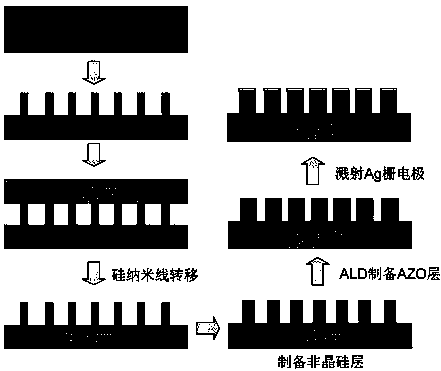Preparation method of flexible substrate silicon nanowire heterojunction solar cell
A technology of silicon nanowires and flexible substrates, applied in the field of solar cells, can solve problems such as impossible industrial production
- Summary
- Abstract
- Description
- Claims
- Application Information
AI Technical Summary
Problems solved by technology
Method used
Image
Examples
example 1
[0026] Example one Copper foil / p-type monocrystalline silicon nanowire / amorphous silicon passivation layer / n-type silicon thin film / AZO / Ag solar cell
[0027] 1. Preparation of single crystal silicon nanowires with a length of 6 μm:
[0028] A (100) doped p-type silicon wafer is selected, with a resistivity of 1.5 Ωcm and a thickness of 180 μm.
[0029] Dip the silicon wafer into acetone and ethanol for 10 min and ultrasonically clean it to remove the organic impurities on the surface, wash it with deionized water; then immerse it in concentrated H 2 SO 4 :H 2 o 2 =3:1 (volume ratio) mixed solution was boiled at 130°C for 10 min, rinsed with deionized water, and dried with nitrogen gas for later use.
[0030] The easy-to-transfer silicon nanowire arrays were prepared by secondary etching. First, the silicon wafer was immersed in 0.005M AgNO 3 and 5M HF mixed solution for 1min, that is, spread a layer of silver on the surface of the silicon wafer, rinse with deionized wa...
example 2
[0042] Example two Copper foil / n-type monocrystalline silicon nanowire / amorphous silicon passivation layer / p-type silicon film / AZO layer / Ag solar cell
[0043] 1. Preparation of single crystal silicon nanowires with a length of 8 μm:
[0044] A (100) doped n-type silicon wafer is selected, with a resistivity of 1.5 Ωcm and a thickness of 180 μm.
[0045] The steps are the same as step 1 in Example 1, but the corrosion time is 1.3h, as follows:
[0046] Dip the silicon wafer into acetone and ethanol for 10 min and ultrasonically clean it to remove the organic impurities on the surface, wash it with deionized water; then immerse it in concentrated H 2 SO 4 :H 2 o 2 =3:1 (volume ratio) mixed solution was boiled at 130°C for 10 min, rinsed with deionized water, and dried with nitrogen gas for later use.
[0047] The easy-to-transfer silicon nanowire arrays were prepared by secondary etching. First, the silicon wafer was immersed in 0.005M AgNO 3 and 5M HF mixed solution fo...
PUM
| Property | Measurement | Unit |
|---|---|---|
| Resistivity | aaaaa | aaaaa |
| Thickness | aaaaa | aaaaa |
| Thickness | aaaaa | aaaaa |
Abstract
Description
Claims
Application Information
 Login to View More
Login to View More - R&D
- Intellectual Property
- Life Sciences
- Materials
- Tech Scout
- Unparalleled Data Quality
- Higher Quality Content
- 60% Fewer Hallucinations
Browse by: Latest US Patents, China's latest patents, Technical Efficacy Thesaurus, Application Domain, Technology Topic, Popular Technical Reports.
© 2025 PatSnap. All rights reserved.Legal|Privacy policy|Modern Slavery Act Transparency Statement|Sitemap|About US| Contact US: help@patsnap.com


